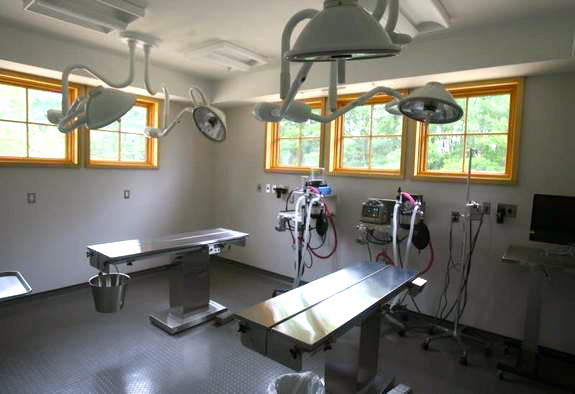Hone + Associates Architects designed our building in cooperation with Design Learned, Inc.
Unique Veterinary Facility
 Janisse M. Cailles and her husband, designer/builder Glenn Likus, believe that a veterinary hospital can provide outstanding veterinary care in an environmentally respectful building. Historically, veterinary hospitals have not been energy efficient. Modern facilities are often energy “burners” not “savers.” The Cailles-Likus team collaborated on their dream of veterinary excellence in an environmentally friendly building. Oldwick Animal Hospital is the result of their pursuit.
Janisse M. Cailles and her husband, designer/builder Glenn Likus, believe that a veterinary hospital can provide outstanding veterinary care in an environmentally respectful building. Historically, veterinary hospitals have not been energy efficient. Modern facilities are often energy “burners” not “savers.” The Cailles-Likus team collaborated on their dream of veterinary excellence in an environmentally friendly building. Oldwick Animal Hospital is the result of their pursuit.
Green Building
Jan Cailles and Glenn Likus applied their ecological building philosophy to every aspect of the hospital’s design. Visitors will readily appreciate the harmony of subtle details such as discreet lighting, colors and materials. The building exemplifies environmental conservation in less obvious features such as the water harvesting method and heat recovery system. Even the landscaping features indigenous plants irrigated from rainwater runoff.
Compatibility with the Physical Environment
The Oldwick Animal Hospital is located on Oldwick Road (just off Rt 78 along Rte 523/517) in Tewksbury Township. The design blends the agrarian roots of early Hunterdon County together with our twenty-first century development as a residential district. The farmhouse style building blends easily into this family oriented community. The hospital is a registered LEED project.
What is LEED?
Leed is an acronym for Leadership in Energy and Environmental Design.
In short, LEED is a rating system for buildings, equivalent to a gas mileage rating for cars. Under LEED, buildings accumulate points for things such as saving energy, having accessible mass transit, and mitigating storm water runoff. Once the points are tallied, the building earns a LEED rating. The higher the tally, the more sustainable a building is.
LEED is an internationally recognized green building certification system which provides third-party verification that a building or community was designed and built using strategies aimed at increasing performance, reducing waste, and improving quality of life.
Source: Everblue Training Institute
Setting a New Standard for Building Within the Veterinary Profession
 For the veterinary industry, Oldwick Animal Hospital models the application of “green” standards to the design of new animal care facilities. Design demands unique to veterinary practice need not be sacrificed to achieve energy conservation.
For the veterinary industry, Oldwick Animal Hospital models the application of “green” standards to the design of new animal care facilities. Design demands unique to veterinary practice need not be sacrificed to achieve energy conservation.
As space in Hunterdon County becomes more and more scarce, the Oldwick Animal Hospital demonstrates application of judicious planning/zoning in which low-impact businesses buffer the transition from residential to business districts. This concept is especially effective in Hunterdon County because the physical design of the hospital is in keeping with surrounding community structures.
Highlights of the Oldwick Animal Hospital “Green Building”; with Attention to its Impact on Future Community:
- Geothermal heat as the primary heating/cooling source, which utilizes a closed loop system that is designed to have the least possible impact on the water table. (In fact, Oldwick Animal Hospital causes no impact on the water table.)
- Water harvesting tanks save rain water for irrigation and other non-potable water usage.
- A storm water cleaning device purifies the water that runs off the parking area before it is slowly released back into the environment.
- Landscaping design utilizes indigenous plantings and shading of the building to decrease energy demands.
- Color choices for roof and building promote lower heating and cooling demands.
- High efficiency insulation utilizing recycled materials.
- Wood products came from renewable sources (FSB certified).
- Reclaimed wood where possible.
- High efficiency windows (r rating).
- Building design for window placement takes advantage of natural light to decrease electrical needs.
- Outdoor lighting design minimizes light “pollution.”
- Utilization of adhesive products with low/no VOC’s (volatile gas emissions).
- Flooring choice based upon low VOC emissions.
- High energy efficient appliances/ dual flush toilets.
- Heat recovery units for higher heating efficiency.
- Siding with recycled content, as well as local procurement to minimize trucking.
- All materials considered were evaluated for distance to obtain to minimize trucking /fuel consumption.
- Recycle plan for all construction waste.
- Re-use of the previous structure that was on the property when obtained.
- Light controls / occupancy sensors inside the building for electrical efficiency.
- Use of energy efficient light bulbs (fluorescent) and calculated lowest-need lighting.